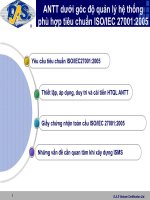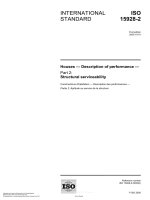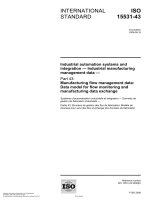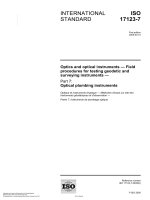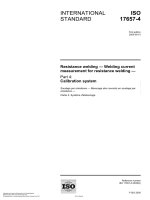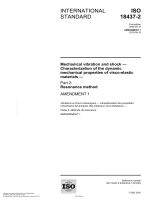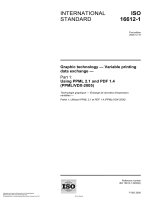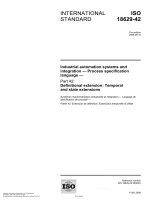Tiêu chuẩn iso 15531 42 2005
Bạn đang xem bản rút gọn của tài liệu. Xem và tải ngay bản đầy đủ của tài liệu tại đây (495.49 KB, 50 trang )
INTERNATIONAL
STANDARD
ISO
15531-42
First edition
2005-09-15
Industrial automation systems and
integration — Industrial manufacturing
management data —
Part 42:
Time Model
Systèmes d'automatisation industrielle et intégration — Données de
gestion de fabrication industrielle —
Partie 42: Modèle du temps
--`,,```,,,,````-`-`,,`,,`,`,,`---
Reference number
ISO 15531-42:2005(E)
Copyright International Organization for Standardization
Reproduced by IHS under license with ISO
No reproduction or networking permitted without license from IHS
© ISO 2005
Not for Resale
ISO 15531-42:2005(E)
PDF disclaimer
This PDF file may contain embedded typefaces. In accordance with Adobe's licensing policy, this file may be printed or viewed but
shall not be edited unless the typefaces which are embedded are licensed to and installed on the computer performing the editing. In
downloading this file, parties accept therein the responsibility of not infringing Adobe's licensing policy. The ISO Central Secretariat
accepts no liability in this area.
Adobe is a trademark of Adobe Systems Incorporated.
Details of the software products used to create this PDF file can be found in the General Info relative to the file; the PDF-creation
parameters were optimized for printing. Every care has been taken to ensure that the file is suitable for use by ISO member bodies. In
the unlikely event that a problem relating to it is found, please inform the Central Secretariat at the address given below.
--`,,```,,,,````-`-`,,`,,`,`,,`---
© ISO 2005
All rights reserved. Unless otherwise specified, no part of this publication may be reproduced or utilized in any form or by any means,
electronic or mechanical, including photocopying and microfilm, without permission in writing from either ISO at the address below or
ISO's member body in the country of the requester.
ISO copyright office
Case postale 56 • CH-1211 Geneva 20
Tel. + 41 22 749 01 11
Fax + 41 22 749 09 47
Web www.iso.org
Published in Switzerland
ii
Copyright International Organization for Standardization
Reproduced by IHS under license with ISO
No reproduction or networking permitted without license from IHS
© ISO 2005 – All rights reserved
Not for Resale
ISO 15531-42 : 2005 (E)
Contents
page
Scope ............................................................................................................................................... 1
Normative references....................................................................................................................... 1
Terms, definitions and abbreviations .............................................................................................. 2
3.1
Terms and definitions .............................................................................................................. 2
3.2
Abbreviated terms ................................................................................................................... 6
4
Overview of the whole ISO 15531 scope....................................................................................... 6
5
Domain property ............................................................................................................................. 7
5.1
Preamble.................................................................................................................................. 7
5.2
Fundamental concepts and assumptions.................................................................................. 7
5.3
Domain property schema definition ........................................................................................ 8
5.4
Domain property type definitions............................................................................................ 8
5.4.1
type_of_identifier_of_dom_gen_struct ........................................................................... 8
5.4.2
type_of_domain............................................................................................................... 9
5.5
domain_property subtype constraint definitions ..................................................................... 9
5.5.1
covered_range ................................................................................................................. 9
5.5.2
complcompos_discrcont_bounded .................................................................................. 9
5.5.3
complete_composite ........................................................................................................ 9
5.5.4
discrete_continuous ....................................................................................................... 10
5.5.5
lower_upper................................................................................................................... 10
5.5.6
compl_continuous_discrete ........................................................................................... 10
5.5.7
compos_continuous_discrete......................................................................................... 11
5.5.8
cont_complete_composite ............................................................................................. 11
5.5.9
disc_complete_composite.............................................................................................. 11
5.5.10 both_bd_compl_compos_disc_cont .............................................................................. 11
5.5.11 low_bd_compl_compos_disc_cont ............................................................................... 12
5.5.12 up_bd_compl_compos_disc_cont ................................................................................. 12
5.5.13 compl_disc_low_both_up ............................................................................................. 13
5.5.14 compl_cont_low_both_up ............................................................................................. 13
5.5.15 compos_cont_low_both_up........................................................................................... 13
5.5.16 compos_disc_low_both_up ........................................................................................... 14
5.6
Domain property entity definitions ....................................................................................... 14
5.6.1
domain ........................................................................................................................... 14
5.6.2
time_domain .................................................................................................................. 14
5.6.3
domain_generic_structure ............................................................................................. 15
5.6.4
complete_or_composite_domain................................................................................... 15
5.6.5
discrete_or_continuous_domain.................................................................................... 16
5.6.6
bounded_domain ........................................................................................................... 16
5.6.7
complete_domain .......................................................................................................... 16
5.6.8
composite_domain......................................................................................................... 17
5.6.9
continuous_domain ....................................................................................................... 17
5.6.10 discrete_domain............................................................................................................. 17
5.6.11 lower_bounded_domain ................................................................................................ 18
5.6.12 upper_bounded_domain ................................................................................................ 18
5.6.13 both_sides_bounded_domain ........................................................................................ 18
5.6.14 complete_continuous_domain....................................................................................... 19
5.6.15 lower_bounded_complete_continuous_domain ............................................................ 19
1
2
3
ISO 2005 All rights reserved
iii
--`,,```,,,,````-`-`,,`,,`,`,,`---
Copyright International Organization for Standardization
Reproduced by IHS under license with ISO
No reproduction or networking permitted without license from IHS
Not for Resale
5.6.16 upper_bounded_complete_continuous_domain ............................................................ 19
5.6.17 both_sides_bounded_complete_continuous_domain .................................................... 20
5.6.18 composite_continuous_domain ..................................................................................... 20
5.6.19 lower_bounded_composite_continuous_domain .......................................................... 20
5.6.20 upper_bounded_composite_continuous_domain .......................................................... 20
5.6.21 both_sides_bounded_composite_continuous_domain .................................................. 21
5.6.22 complete_discrete_domain ............................................................................................ 21
5.6.23 lower_bounded_complete_discrete_domain ................................................................. 21
5.6.24 upper_bounded_complete_discrete_domain ................................................................. 21
5.6.25 both_sides_bounded_complete_discrete_domain ......................................................... 22
5.6.26 composite_discrete_domain .......................................................................................... 22
5.6.27 lower_bounded_composite_discrete_domain ............................................................... 22
5.6.28 upper_bounded_composite_discrete_domain ............................................................... 22
5.6.29 both_sides_bounded_composite_discrete_domain ....................................................... 23
5.6.30 domain_point................................................................................................................. 23
6
Time domain.................................................................................................................................. 23
6.1
Preamble................................................................................................................................ 23
6.2
Fundamental concepts and assumptions................................................................................ 24
6.3
Time domain schema definition ............................................................................................ 24
6.4
Time domain type definitions................................................................................................ 25
6.4.1
type_of_description_of_tranformation_rule.................................................................. 25
6.4.2
type_of_value_of_point_or_interval_in_time............................................................... 25
6.5
Time domain entity definitions ............................................................................................. 26
6.5.1
interval_of_time ............................................................................................................ 26
6.5.2
point_in_time................................................................................................................. 26
6.5.3
frequency_of_event ....................................................................................................... 26
6.5.4
time_domain_relation.................................................................................................... 27
6.5.5
rule_of_reference_to_origin_relation............................................................................ 27
6.5.6
rule_of_unit_relation ..................................................................................................... 28
6.5.7
time_unit_relation ......................................................................................................... 28
6.5.8
point_in_time_event_assignment .................................................................................. 28
6.5.9
point_in_time_event_assignment_role.......................................................................... 29
6.6
Time domain function definition........................................................................................... 29
Annex A (normative) Use of ASN.1 Identifiers in SC4 standards........................................................ 31
Annex B (informative) EXPRESS listing ............................................................................................. 32
Annex C (informative) EXPRESS-G figures ........................................................................................ 39
Bibliography.......................................................................................................................................... 42
Index...................................................................................................................................................... 43
Figures
Figure C.1 domain_property schema .................................................................................................... 39
Figure C.2 time_domain schema (1/2) .................................................................................................. 40
Figure C.3 time_domain schema (2/2) .................................................................................................. 41
ISO 2005 All rights reserved
iv
Copyright International Organization for Standardization
Reproduced by IHS under license with ISO
No reproduction or networking permitted without license from IHS
Not for Resale
--`,,```,,,,````-`-`,,`,,`,`,,`---
ISO 15531-42 : 2005 (E)
ISO 15531-42 : 2005 (E)
Foreword
The International Organisation for Standardisation (ISO) is a worldwide federation of national
standards bodies (ISO member bodies). The work of preparing International Standards is normally
carried out through ISO technical committees. Each member body interested in a subject for which a
technical committee has been established has the right to be represented on that committee.
International organisations, governmental and non-governmental, in liaison with ISO, also take part in
the work. ISO collaborates closely with the International Electrotechnical Commission (IEC) on all
matters of electrotechnical standardization.
International Standards are drafted in accordance with the rules given in ISO/IEC Directives, Part 2.
Draft International Standards (DIS) adopted by technical committees are circulated to the member
bodies for voting. Publication as an International Standard requires approval by at least 75% of the
member bodies casting a vote.
Attention is drawn to the possibility that some of the elements of this part of ISO 15531 may be the
subject of patent rights. ISO shall not be held responsible for identifying any or all such patent rights.
This part of ISO 15531 was prepared by the Technical committee ISO/TC 184 Industrial automation
systems and integration, Sub-Committee 4 Industrial data.
A complete list of parts of ISO 15531 is available from the Internet.
/>
ISO 2005 All rights reserved
v
--`,,```,,,,````-`-`,,`,,`,`,,`---
Copyright International Organization for Standardization
Reproduced by IHS under license with ISO
No reproduction or networking permitted without license from IHS
Not for Resale
ISO 15531-42 : 2005 (E)
Introduction
Software applications related to factory or enterprise production, such as scheduling software,
manufacturing management software, cost evaluation software, maintenance management, purchasing
software, delivery software..., strongly require a reference to time related features such as point in time
(date) and duration (interval of time). These references are needed to ensure the necessary time related
relationships between the events dealt with by the applications.
The availability of standardised time related references is particularly important for complex
applications with multi-process environments, what is an environment commonly met in
manufacturing.
In most of the standards, the time features are not independent from the events and the manufacturing
management data they address. This leads to some difficulties in the way to handle time related
relationships between events or data that include their own time relation and representation. In some of
them the time related features may depend on events or objects addressed and their representation may
change depending on the context, without any simple tool to identify the relation between them. This
may be crucial in an environment where various processes are performed simultaneously or where
many closely related software tools are used at the same time.
Developed in compliance with the “System theory” approach this part of ISO 15531 identifies the time
as a constraint of the system environment and provides time related features included in a time model
fully independent from the events handled by the manufacturing system. This time model is also fully
independent from any manufacturing management data used by the manufacturing applications.
Note: For further explanations on time related concepts in system theory see ISO 15531-31 annex D.
Furthermore the time domain makes use of a domain property schema that, as one dimension domain,
is generic enough to be usable separately from time specific properties.
In addition, the time model provided in this standard is written in EXPRESS to ensure better
compatibility with ISO 10303.
Note: The background of this standard comes from the initial work developed in the JWG8 by Professor
Dangelmaier from the Hans Nixdorf Institute of the Paderborn University, Germany.
ISO 2005 All rights reserved
vi
--`,,```,,,,````-`-`,,`,,`,`,,`---
Copyright International Organization for Standardization
Reproduced by IHS under license with ISO
No reproduction or networking permitted without license from IHS
Not for Resale
INTERNATIONAL STANDARD
ISO 15531-42:2005(E)
--`,,```,,,,````-`-`,,`,,`,`,,`---
Industrial automation systems and integration — Industrial
manufacturing management data —
Part 42:
Time Model
1
Scope
This part of ISO 15531 specifies a generic framework for the description of topological properties
applicable to a wide range of one dimension domains.
However, and given the needs of the other parts of ISO 15531, the developments made in this part are
focused on the time domain, thus providing a universal, self consistent model, independent of any
event that may occur, or has already occurred, at a given point in time.
The time model specified in this part enables any software application to provide an accurate time
reference to any related event, or sequence of events, whether in the past, in the present, or in the
future. This time model may be used by any application that needs to reference events, actions, or
sequences of action linked to time or intervals of time simultaneously.
According to this, the scope of this part of ISO 15531 includes the following:
— the description of the topological properties of an one dimension domain;
— the description of the time model and of the related definitions;
— the EXPRESS definitions of entities, attributes and schemas as prescribed in ISO 10303-11 (the
reference manual of the EXPRESS language);
— the EXPRESS-G diagrams of the model as prescribed in ISO 10303-11.
The following are out of the scope of this part of ISO 15531:
— the description of any kind of measure theory or measure method
— elements and domains of more than one dimension
— the modelling of any event as described in ISO 10303-41
EXAMPLE Since their domain dimension is greater than one, squares, rectangles, triangles,..as well as cubes
and spheres are out of the scope of this part of ISO 15531.
2
Normative references
The following referenced documents are indispensable for the application of this document. For dated
references, only the edition cited applies. For undated references, the latest edition of the referenced
document (including any amendments) applies.
ISO 2005 All rights reserved
Copyright International Organization for Standardization
Reproduced by IHS under license with ISO
No reproduction or networking permitted without license from IHS
1
Not for Resale
ISO 15531-42 : 2005 (E)
ISO/IEC 8824-1: Information Technology — Abstract Syntax Notation One (ASN.1) — Specification of
Basic Notation — Part 1.
ISO 10303-11: Industrial automation systems and integration ― Product data representation and
exchange ― Part 11: Description methods: The EXPRESS language reference manual.
ISO 10303-41: Industrial automation systems and integration ― Product data representation and
exchange ― Part 41: Integrated generic resource: Fundamentals of product description and support.
ISO 15531-1: Industrial automation systems and integration ― Industrial manufacturing
management data ― Part 1: General overview.
3
Terms, definitions and abbreviations
3.1 Terms and definitions
For the purposes of this document, the following terms and definitions apply.
3.1.1
discrete manufacturing
production of discrete items.
[ISO 15531-1]
3.1.2
domain
collection of one dimension elements, that can be ordered and positionned applying a given measure
method
NOTE Since the purpose of this document is the description of a “time model” the restriction of “one
dimension” element in the definition only applies to this document that excludes domain such as rectangle,
triangle, cubes and spheres. Whithout the restriction to “one dimension” element the definition may apply to any
kind of domain.
EXAMPLE a domain can be specified as a list of integers such as 1, 2, 3,4….
--`,,```,,,,````-`-`,,`,,`,`,,`---
3.1.3
domain point
point in a domain
domain element for which any defined measure of it in the domain is zero
3.1.4
element
static representation of a part of the universe of discourse that may be identified and characterised by
its behaviour and attributes
ISO 2005 All rights reserved
2
Copyright International Organization for Standardization
Reproduced by IHS under license with ISO
No reproduction or networking permitted without license from IHS
Not for Resale
ISO 15531-42 : 2005 (E)
NOTE A static representation is a snapshot of the part of the universe of discourse under consideration at a
given time. It may include dynamic attributes as, for example, behaviour. Those attributes characterise the
element as it is or as it is expected to be at a given time.
[ISO 15531-1]
3.1.5
entity
a class of information defined by common properties
[ISO 10303-11]
3.1.6
environment
part of the universe of discourse that does not belong to the system itself
EXAMPLE inputs and outputs of the systems such as raw material, final products etc., belong to the
environment of the system as well as constraints that apply to it or time
3.1.7
event_occurrence
fact of an existence of a state at some point in time
NOTE the point in time of the existence may not be known in term of calendar date before the
event_occurrence actually happens. One reason, why the event_occurrence cannot always be expressed as a
calendar date, is that the event_occurrence is not possible to plan, for example a breakdown of machine.
--`,,```,,,,````-`-`,,`,,`,`,,`---
EXAMPLE “Start of production”, “breakdown of machine A”.
[ISO 10303-41ed2 clause 16.4.7]
3.1.8
flow
motion of a set of physical or informational objects in space and time
[ISO 15531-1]
3.1.9
flow control
specific production control system that is based primarily on setting production rates and feeding work
into production to meet these planned rates, then monitoring and controlling production.
NOTE That includes the act of checking and driving the flow according to a given purpose. The term may also
apply to the function or service.
3.1.10
duration
interval of time
length of a period of time, measured using a given unit of time
EXAMPLE 1 the 24 hours between Monday 1.00 p.m. and Tuesday 12.00 a.m.
ISO 2005 All rights reserved
Copyright International Organization for Standardization
Reproduced by IHS under license with ISO
No reproduction or networking permitted without license from IHS
3
Not for Resale
ISO 15531-42 : 2005 (E)
EXAMPLE 2 every Monday of every week between January and July.
NOTE interval of time measures the distance between two points in time. In that case it is the length of the time
domain that is bounded by the two points in time under consideration.
3.1.11
measure
result of a quantitative evaluation of a given property of any physical or mathematical object
NOTE 1 the term measure may also be utilised for the operation that leads to this result.
EXAMPLE
measure of length, area, volume, mass distribution, probability distribution, period of time, etc.
NOTE 2 any measure implies the definition of a method (procedure, theory) to get it, that includes the definition
of the correponding unit of the measure. In particular any measure of an interval of time shall imply the
definition of a unit of time and shall refer to it.
NOTE 3 From a mathematical point of view a measure is sometimes defined as a way to determine the distance
between two points of the space under consideration (the length of the segment that joint these two points) as
well as the result . In that sense duration is the measure of a period of time.
3.1.12
method of measure
set of rules and intermediate steps, including the definition and the use of a unit of measure to be
observed to achieve the considered measure
NOTE 1 Methods of measure often result from theories and principles that implicitly or explicitly derive from
mathematical theories of the measure theories and from theoritical or experimental considerations on the
property to be assessed.
NOTE 2 Mathematical theory of the measure theory is the study of measurable sets and functions, introduced by
Lebesgue in order to generalize the Riemann integral.
3.1.13
point in time
location of something noticeable within a time domain
NOTE another equivallent definition may be : point in the time domain, applying definition 3.4.1 and 3.4.2 to
the time domain
EXAMPLE 1 Wednesday, 15th of March, 2003.
EXAMPLE 2 9.30 a.m.
3.1.14
scheduling
act, function or result of planning occurrences of manufacturing activities
ISO 2005 All rights reserved
4
Copyright International Organization for Standardization
Reproduced by IHS under license with ISO
No reproduction or networking permitted without license from IHS
Not for Resale
--`,,```,,,,````-`-`,,`,,`,`,,`---
NOTE 4 For information the generic mathematical definition of the measure is : nonnegative function of subsets
of a space completely additive in the sense that the measure of the union of a sequence of mutually disjoint sets
is the sum of the measures of the sets.
ISO 15531-42 : 2005 (E)
[ISO 15531-1]
--`,,```,,,,````-`-`,,`,,`,`,,`---
3.1.15
time
feature of the enterprise universe of discourse that enables the location of noticeable things along an
infinite oriented axis and allows the ordering of their succession or the identification and
characterisation of this succession
EXAMPLE noticeable things may be events that have occurred, that may occur or are expected to occur. That
may also be tags along the time axis.
NOTE Two main enterprise entities are related to the time. The first one is the point in time that enables the
identification or assessment of location along the time axis. The second one is the interval of time that enables
the determination of the distance between two points in time. See ISO 15531-31 annex D and IEC 62264-1
annex F.
3.1.16
time domain
period
set of points in time
EXAMPLE 1 the worked period within a year.
EXAMPLE 2 the maintenance period of a machine tool.
NOTE 1 A time domain may be finite or infinite. It may be bounded or not by one or two points in time.
NOTE 2 A time domain may be composed of other time domains.
3.1.17
time_interval
Identification of an intervening time
EXAMPLE “strike duration”, “delay of production”, “Christmas holydays”
[ISO 10303-41ed2 clause 16.4.14]
3.1.18
time model
model of the enterprise environment feature “time”
[ISO 15531-1]
3.1.19
unit of time
unit, that is implicitly or explicitly a multiple of the internationally defined second, to which a measure
of time in a time domain has to refer
NOTE 1 in other words unit of time is the quantity of time chosen as a reference in terms of witch other quantity
of time may be expressed. The second is the unit of time defined in the SI system of units.
ISO 2005 All rights reserved
Copyright International Organization for Standardization
Reproduced by IHS under license with ISO
No reproduction or networking permitted without license from IHS
5
Not for Resale
ISO 15531-42 : 2005 (E)
NOTE 2 the multiplication ratio may be either greater or smaller than one.
3.1.20
universe of discourse
the collection of concrete or abstract things that belong to an area of the real world, selected according
to its interest for the system to be modelled and for its corresponding environment
[ISO 15531-1]
3.2 Abbreviated terms
MANDATE
MANufacturing DATa Exchange
STEP
STandard for the Exchange of Product model data
4
Overview of the whole ISO 15531 scope
ISO 15531 specifies the characteristics for a representation of manufacturing management information
over the entire industrial process with the necessary mechanisms and definitions to enable
manufacturing management data to be shared and exchanged within the factory, with other plants or
with companies.
Exchanges are made through different computer systems and environments associated with the
complete industrial process. The standard is focused on discrete manufacturing but not limited to it.
Nevertheless any extension to industrial processes which does not belong to discrete manufacturing is
always under consideration when it does not imply any contradiction or inconsistency with the initial
objective of the standard.
The following are within the scope of ISO 15531:
the representation of production and resources information including capacity, monitoring,
maintenance constraints and control;
NOTE - Maintenance constraints and relevant maintenance management data are taken into account from the
point of view of their impact on the flow control.
the exchange and sharing of production information and resources information including storing,
transferring, accessing and archiving.
The following are outside the scope of ISO 15531:
enterprise modelling;
NOTE - That means that tools, architecture and methodologies for the modelling of an enterprise in its whole
are not in the scope of ISO 15531.
product data (representation and exchange of product information);
component data (parts library: representation and exchange of computer-interpretable parts library
information);
ISO 2005 All rights reserved
6
--`,,```,,,,````-`-`,,`,,`,`,,`---
Copyright International Organization for Standardization
Reproduced by IHS under license with ISO
No reproduction or networking permitted without license from IHS
Not for Resale
ISO 15531-42 : 2005 (E)
cutting tools (electronic representation for exchange of cutting tool data);
technical maintenance information (technical information such as those included in devices repair,
operation and maintenance manuals).
ISO 15531-1 provides a full overview of the whole ISO 15531 and of the relationship between its
different parts.
5
Domain property
5.1 Preamble
The domain property schema provides a generic structure applicable to any one dimension domain,
enabling a hierarchical decomposition at the upper level of the tree, becoming then a network at the
lower levels of the decomposition.
The root of the tree is made of an abstract entity called domain. This domain is considered as a set of
domain points. This entity defines, in turn, the abstract supertype of three other abstract entities:
complete or composite domain, discrete or continuous domain and bounded domain, characterizing the
three basic categories from which the different kinds of domains are built. These four entities define
the fundamental elements on which the domain property schema is built.
At the third level of the hierarchy, the three abstract entities of the second level are split into two subcategories, leading to the entities of the fourth level. The entities belonging to the fourth level are
related in between them through a network structure. This network structure comes from fundamental
topological features of a domain, mentioned below.
5.2 Fundamental concepts and assumptions
Basically, the fundamental properties of a given domain are aimed at providing the possibility of
covering the following range of topological structures for a set of domain points:
— complete;
— composite;
— discrete;
— continuous;
— upper-bounded;
— lower-bounded.
Combining the entities of each of the three initial branches with entities of the other branches leads to
a network of combinations. the combinations are made in order to keep sense to the resulting entity.
ISO 2005 All rights reserved
Copyright International Organization for Standardization
Reproduced by IHS under license with ISO
No reproduction or networking permitted without license from IHS
7
Not for Resale
--`,,```,,,,````-`-`,,`,,`,`,,`---
The modelling language used to model the manufacturing management data addressed by ISO 15531
is EXPRESS that is defined in ISO 10303-11.
ISO 15531-42 : 2005 (E)
EXAMPLE: possible combinations are:
— lower bounded composite discrete domain
— upper bounded complete continuous domain
In parallel to the definition of all possible domains, another concept enables the definition of domain
points the domain is made of. This concept is necessary to bring a lower bound to a lower bounded
domain, an upper bound to an upper bounded domain and to provide a reference to the origin of the
complete domain entity.
5.3 Domain property schema definition
--`,,```,,,,````-`-`,,`,,`,`,,`---
The following EXPRESS declaration begins the domain_property_schema and identifies the
necessary external references.
EXPRESS specification
*)
SCHEMA domain_property_schema;
REFERENCE FROM measure_schema
(unit);
REFERENCE FROM support_resource_schema
(label);
-- ISO 10303-41
-- ISO 10303-41
(*
NOTE 1 The schemas referred to above can be found in the following parts of ISO 10303-41:
measure_schema: clause 21
support_resource_schema: clause 20
NOTE 2 See annex C.1 for a graphical presentation of this schema using the EXPRESS-G notation.
5.4 Domain property type definitions
5.4.1 type_of_identifier_of_dom_gen_struct
A type_of_identifier_of_dom_gen_struct is an alphanumeric string which may be used for
something to be identified. It does not need to be understandable through the natural language.
EXPRESS-specification:
*)
TYPE type_of_identifier_of_dom_gen_struct = STRING;
END_TYPE;
(*
ISO 2005 All rights reserved
8
Copyright International Organization for Standardization
Reproduced by IHS under license with ISO
No reproduction or networking permitted without license from IHS
Not for Resale
ISO 15531-42 : 2005 (E)
5.4.2 type_of_domain
A type_of_domain is an alphanumeric string which may be used to identify the domain.
EXPRESS-specification:
*)
TYPE type_of_domain = STRING;
END_TYPE;
(*
5.5 domain_property subtype constraint definitions
5.5.1 covered_range
A covered_range is the subtype constraint used to define subtypes of domains for which a
topological structure is needed.
--`,,```,,,,````-`-`,,`,,`,`,,`---
EXPRESS-specification:
*)
SUBTYPE_CONSTRAINT covered_range FOR domain;
ABSTRACT SUPERTYPE;
ONEOF (time_domain);
END_SUBTYPE_CONSTRAINT;
(*
5.5.2 complcompos_discrcont_bounded
A complcompos_discrcont_bounded is the subtype constraint used to define subtypes of
domain_generic_structure related to the property of being either complete, or composite, or discrete,
or continuous, or bounded.
EXPRESS-specification:
*)
SUBTYPE_CONSTRAINT complcompos_discrcont_bounded FOR
domain_generic_structure;
ABSTRACT SUPERTYPE;
ONEOF (complete_or_composite_domain, discrete_or_continuous
_domain, bounded_domain);
END_SUBTYPE_CONSTRAINT;
(*
5.5.3 complete_composite
A complete_composite is the subtype constraint used to define subtypes of
complete_or_composite_domain related to the property of being either complete or composite.
a
ISO 2005 All rights reserved
9
Copyright International Organization for Standardization
Reproduced by IHS under license with ISO
No reproduction or networking permitted without license from IHS
Not for Resale
ISO 15531-42 : 2005 (E)
EXPRESS-specification:
*)
SUBTYPE_CONSTRAINT complete_composite FOR
complete_or_composite_domain;
ABSTRACT SUPERTYPE;
ONEOF (complete_domain, composite_domain);
END_SUBTYPE_CONSTRAINT;
(*
5.5.4 discrete_continuous
A discrete_continuous is the subtype constraint used to define subtypes of
discrete_or_continuous_domain related to the property of being either discrete or continuous.
a
EXPRESS-specification:
*)
SUBTYPE_CONSTRAINT discrete_continuous FOR
discrete_or_continuous_domain;
ABSTRACT SUPERTYPE;
ONEOF (continuous_domain, discrete_domain);
END_SUBTYPE_CONSTRAINT;
(*
5.5.5 lower_upper
A lower_upper is the subtype constraint used to define subtypes of a bounded_domain related to the
property of being either lower bounded or upper bounded.
EXPRESS-specification:
*)
SUBTYPE_CONSTRAINT lower_upper FOR bounded_domain;
ABSTRACT SUPERTYPE;
ONEOF (lower_bounded_domain, upper_bounded_domain);
END_SUBTYPE_CONSTRAINT;
(*
5.5.6 compl_continuous_discrete
--`,,```,,,,````-`-`,,`,,`,`,,`---
A compl_continuous_discrete is the subtype constraint used to define subtypes of a
complete_domain related to the property of being either continuous or discrete.
EXPRESS-specification:
*)
SUBTYPE_CONSTRAINT compl_continuous_discrete FOR complete_domain;
ABSTRACT SUPERTYPE;
ONEOF (complete_continuous_domain, complete_discrete_domain);
ISO 2005 All rights reserved
10
Copyright International Organization for Standardization
Reproduced by IHS under license with ISO
No reproduction or networking permitted without license from IHS
Not for Resale
ISO 15531-42 : 2005 (E)
END_SUBTYPE_CONSTRAINT;
(*
A compos_continuous_discrete is the subtype constraint used to define subtypes of a
composite_domain related to the property of being either continuous or discrete.
EXPRESS-specification:
*)
SUBTYPE_CONSTRAINT compos_continuous_discrete FOR composite_domain;
ABSTRACT SUPERTYPE;
ONEOF (composite_continuous_domain, composite_discrete_domain);
END_SUBTYPE_CONSTRAINT;
(*
5.5.8 cont_complete_composite
A cont_complete_composite is the subtype constraint used to define subtypes of a
continuous_domain related to the property of being either complete or composite..
EXPRESS-specification:
*)
SUBTYPE_CONSTRAINT cont_complete_composite FOR continuous_domain;
ABSTRACT SUPERTYPE;
ONEOF (complete_continuous_domain, composite_continuous_domain);
END_SUBTYPE_CONSTRAINT;
(*
5.5.9 disc_complete_composite
A disc_complete_composite is the subtype constraint used to define subtypes of a discrete_domain
related to the property of being either complete or composite.
EXPRESS-specification:
*)
SUBTYPE_CONSTRAINT disc_complete_composite FOR discrete_domain;
ABSTRACT SUPERTYPE;
ONEOF (complete_discrete_domain, composite_discrete_domain);
END_SUBTYPE_CONSTRAINT;
(*
5.5.10 both_bd_compl_compos_disc_cont
A both_bd_compl_compos_disc_cont is the subtype constraint used to define subtypes of a
both_sides_bounded_domain related to the property of being either complete and continuous, or
ISO 2005 All rights reserved
Copyright International Organization for Standardization
Reproduced by IHS under license with ISO
No reproduction or networking permitted without license from IHS
11
Not for Resale
--`,,```,,,,````-`-`,,`,,`,`,,`---
5.5.7 compos_continuous_discrete
ISO 15531-42 : 2005 (E)
complete and discrete, or composite and continuous, or composite and discrete.
EXPRESS-specification:
*)
SUBTYPE_CONSTRAINT both_bd_compl_compos_disc_cont FOR
both_sides_bounded_domain;
ABSTRACT SUPERTYPE;
ONEOF (both_sides_bounded_complete_continuous_domain,
both_sides_bounded_complete_discrete_domain,
both_sides_bounded_composite_continuous_domain,
both_sides_bounded_composite_discrete_domain);
END_SUBTYPE_CONSTRAINT;
(*
5.5.11 low_bd_compl_compos_disc_cont
A low_bd_compl_compos_disc_cont is the subtype constraint used to define subtypes of a
lower_bounded_domain related to the property of being either complete and continuous, or complete
and discrete, or composite and continuous, or composite and discrete.
EXPRESS-specification:
*)
SUBTYPE_CONSTRAINT low_bd_compl_compos_disc_cont FOR
lower_bounded_domain;
ABSTRACT SUPERTYPE;
ONEOF (lower_bounded_complete_continuous_domain,
lower_bounded_complete_discrete_domain,
lower_bounded_composite_continuous_domain,
lower_bounded_composite_discrete_domain);
END_SUBTYPE_CONSTRAINT;
(*
5.5.12 up_bd_compl_compos_disc_cont
A up_bd_compl_compos_disc_cont is the subtype constraint used to define subtypes of an
upper_bounded_domain related to the property of being either complete and continuous, or complete
and discrete, or composite and continuous, or composite and discrete.
EXPRESS-specification:
ISO 2005 All rights reserved
12
Copyright International Organization for Standardization
Reproduced by IHS under license with ISO
No reproduction or networking permitted without license from IHS
Not for Resale
--`,,```,,,,````-`-`,,`,,`,`,,`---
*)
SUBTYPE_CONSTRAINT up_bd_compl_compos_disc_cont FOR
upper_bounded_domain;
ABSTRACT SUPERTYPE;
ONEOF (upper_bounded_complete_continuous_domain,
upper_bounded_complete_discrete_domain,
upper_bounded_composite_continuous_domain,
upper_bounded_composite_discrete_domain);
END_SUBTYPE_CONSTRAINT;
ISO 15531-42 : 2005 (E)
(*
5.5.13 compl_disc_low_both_up
A compl_disc_low_both_up is the subtype constraint used to define subtypes of a
complete_discrete_domain related to the property of being either lower bounded, or upper bounded,
or both sides bounded.
EXPRESS-specification:
*)
SUBTYPE_CONSTRAINT compl_disc_low_both_up FOR
complete_discrete_domain;
ONEOF (lower_bounded_complete_discrete_domain,
both_sides_bounded_complete_discrete_domain,
upper_bounded_complete_discrete_domain);
END_SUBTYPE_CONSTRAINT;
(*
5.5.14 compl_cont_low_both_up
A compl_cont_low_both_up is the subtype constraint used to define subtypes of a
complete_continuous_domain related to the property of being either lower bounded, or upper
bounded, or both sides bounded.
EXPRESS-specification:
*)
SUBTYPE_CONSTRAINT compl_cont_low_both_up FOR
complete_continuous_domain;
ONEOF (lower_bounded_complete_continuous_domain,
both_sides_bounded_complete_continuous_domain,
upper_bounded_complete_continuous_domain);
END_SUBTYPE_CONSTRAINT;
(*
5.5.15 compos_cont_low_both_up
A compos_cont_low_both_up is the subtype constraint used to define subtypes of a
composite_continuous_domain related to the property of being either lower bounded, or upper
bounded, or both sides bounded.
EXPRESS-specification:
*)
SUBTYPE_CONSTRAINT compos_cont_low_both_up FOR
composite_continuous_domain;
ONEOF (lower_bounded_composite_continuous_domain,
both_sides_bounded_composite_continuous_domain,
upper_bounded_composite_continuous_domain);
ISO 2005 All rights reserved
13
--`,,```,,,,````-`-`,,`,,`,`,,`---
Copyright International Organization for Standardization
Reproduced by IHS under license with ISO
No reproduction or networking permitted without license from IHS
Not for Resale
ISO 15531-42 : 2005 (E)
END_SUBTYPE_CONSTRAINT;
(*
5.5.16 compos_disc_low_both_up
A compos_disc_low_both_up is the subtype constraint used to define subtypes of a
composite_discrete_domain related to the property of being either lower bounded, or upper bounded,
or both sides bounded.
EXPRESS-specification:
*)
SUBTYPE_CONSTRAINT compos_disc_low_both_up FOR
composite_discrete_domain;
ONEOF (lower_bounded_composite_discrete_domain,
both_sides_bounded_composite_discrete_domain,
upper_bounded_composite_discrete_domain);
END_SUBTYPE_CONSTRAINT;
*)
5.6 Domain property entity definitions
5.6.1 domain
As indicated in the clause 3.4.1 a domain is a collection of elements that can be ordered and positioned
appling a given method of measure. In this document only one dimension domains and one dimension
elements are considered.
EXPRESS-specification:
*)
ENTITY domain;
id: type_of_domain;
UNIQUE
UR1: id;
END_ENTITY;
(*
Attribute definitions:
id: allows a domain to be identified.
Formal propositions:
UR1: the identification of the domain shall be unique.
5.6.2 time_domain
A time_domain is a domain which is able to contain a sequence of points in time.
EXAMPLE 1 - A time_domain can be specified as the list of all years in an gregorian calendar:
{..., 1955, 1956, 1957,...}.
ISO 2005 All rights reserved
14
--`,,```,,,,````-`-`,,`,,`,`,,`---
Copyright International Organization for Standardization
Reproduced by IHS under license with ISO
No reproduction or networking permitted without license from IHS
Not for Resale
